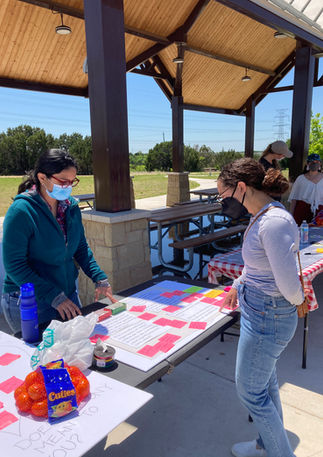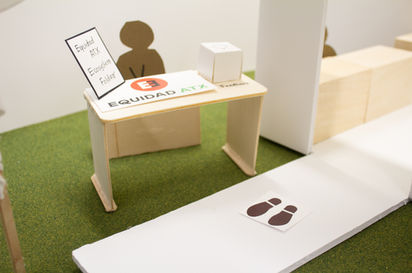
*scroll down to view the full-service video
LIVE WELL/VIVE BIEN
ADDRESSING FOOD INSECURITY THROUGH PARTICIPATORY DESIGN.
In collaboration with an Austin-based nonprofit organization, Equidad ATX, my team and I designed an inclusive & COVID safe mobile grocery store shopping experience and service in five months.
Team: Zaara Qasim, Nirali Oza, Alok Doshi, Noella Kiza, Brittanie Wilczak
THE CHALLENGE
How might we best utilize a retrofitted Cap Metro bus* to co-design a sustainable and holistic experience with our target communities to address food insecurity in a dignified and COVID-safe manner?
*The Capital Metropolitan Transportation Authority, commonly Capital Metro or Cap Metro, is a public transportation provider located in Austin, Texas.
THE APPROACH
-
We utilized several participatory and service design methods to execute a community-first approach.
-
Through contextual inquiry and card sorting activities, we built relationships with users and learned about the community and priorities.
-
We also created business origami and prototypes to help our stakeholders envision and co-create an entirely new service plan to streamline and prioritize their efforts.
THE OUTCOME
We delivered two visual artifacts that served as tools to generate buy-in from partners and communities for our ideas - a service concept video and a foam-core model of the mobile market. They also motivated the community members to participate and support our client in revitalizing the neighborhood.
Additionally, our insights, recommendations, and business origami map provided our project partner with a solid, actionable framework for immediate next steps as well as strategic directions for long-term execution.
MY ROLE
As a service designer and a visual designer,
I contributed to this project in the following ways:
-
Led the research phase, including generating the proposal draft, research plans, and final deliverables.
-
Conceptualized, planned, and created assets for the participatory design activities, business origami prototyping exercise, and service concept video.
-
Collaborated with the team in facilitating community engagement and co-design activities.
-
Planned and directed the production of the foam-core model and service concept video.
"I LOVED HOW GROUNDED YOUR WORK WAS IN BRINGING THE COMMUNITY VOICE AND SHARING THE BEST PRACTICES/ EXAMPLES OF SUCCESS FROM THE FIELD. THANKS FOR WHAT YOU AND OTHERS ARE DOING TO IMPROVE LIVES AND HELP MAKE AUSTIN A PLACE WHERE EVERYONE THRIVES."
- Equidad Board Member after our presentation
FINAL SERVICE DESIGN CONCEPT VIDEO
Unmute video to hear the narration.
01
THE CHALLENGE
Austin's Eastern Crescent is an area living in the legacy of the 1928 Master Plan, which created a racially and geographically segregated district in Austin, TX east of I-35. The communities in the Eastern Crescent exist in an Urban Desert, experiencing limited access to affordable healthy food and access to healthcare, leading to lower life expectancies and higher age-adjusted mortality rates than those living west of I-35. This situation has been further exaggerated by the COVID-19 pandemic, leaving vulnerable populations even more vulnerable.
Live Well Vive Bien, an initiative piloted by Equidad ATX, aims to address food insecurity in the communities of Colony Park, Del Valle, and Creedmoor in Austin, TX through an incredible experience revolving around a retrofitted decommissioned Cap Metro bus that would meet people where they are. Our three main challenges were:
-
Identify the communities' needs and priorities
-
Generate buy-in from partners and communities for the mobile services
-
Reimagine the proposed services through a COVID-safe lens
With this context, we framed our challenge with the following prompt: How might we best utilize a retrofitted Cap Metro bus* to co-design a sustainable and holistic experience with our target communities to address food insecurity in a dignified and COVID-safe manner?

Image Source: The Austin Chronicle
“IT IS DIFFICULT TO UNDERSTAND IN THIS DAY AND TIME WHY WE DON'T HAVE THE SAME THING THAT EVERY OTHER COMMUNITY HAS."
- Ms. S, Colony Park Community Member
02
THE APPROACH
We divided our design research efforts into four major areas of investigation: People, Places, Partners, and Plans.
-
People: For People, we asked “Who are the communities we are designing with?” We began by conducting a literature review of existing community demographic and health data. We then conducted interviews with various community leaders and members and facilitated a card sorting activity aimed at discovering the community’s needs and preferences around food.
-
Places: For Places, we wanted to visit places where the community has meaningful interactions with food. To this end, we went on a tour of Colony Park with community leaders and conducted field visits to local grocery stores, food banks, and farms.
-
Partners: For Partners, we asked, “Who are we working with?” We conducted interviews with members of the Central Texas Food Bank, Purpose-Built Communities, Urban Roots, Farm Share, Gensler Architecture, and many more. Additionally, we attended The National Mobile Food Market Summit, to build connections and learn from existing mobile grocery store models and designs.
-
Plans: Finally, for Plans, we asked, “What has already been done?” Knowing that significant time and effort had been already invested into the Live Well project before we joined, we conducted interviews with internal and external stakeholders who had been working on Live Well since the beginning to understand their progress, learnings, and challenges to date.
In five months, we conducted 20 semi-structured interviews, 8 field visits, and 11 community engagement and participatory design activities.
RESEARCH BLUEPRINT

COMMUNITY ENGAGEMENT ACTIVITY
Pictures taken by the team during community engagement activites.
“IN TERMS OF FOOD BARRIERS, A LOT OF THE FOOD THAT PROGRAMS LIKE URBAN ROOTS AND SUSTAINABLE FARM AND FARM SHARE PUT OUT IS JUST NOT ETHNICALLY DIVERSE."
- Ms. O, Community Member
03
THE OUTCOME
As we gathered data, we began the process of sense-making to synthesize the information we collected.
-
We started to see common patterns in our data through thematic analysis and affinity diagramming, which led us to identify themes.
-
From the data gathered in our interviews with community members, we developed empathy maps to better understand the community's needs.
-
We also used the AEIOU framework to develop additional observations and uncover insights.
Our final deliverable included an insights report, model prototype, business origami, recommendations, and a full-service concept video.
INSIGHTS
01.
Consistency and visibility
In a community that has seen many organizations come and go without lasting change, consistency in both visibility and physical presence is essential to building trust.
03.
Diversity
When determining community needs, it is tempting to think of Colony Park as one unit however, the reality is that Colony Park is an incredibly diverse area, and its needs reflect its diversity.
05.
Meaning of food
The significance of food varies amongst the diverse communities of Colony Park; for some, it is a means for health and sustenance, while for others, it defines culture & identity.
02.
Unkept promises
Many residents took action to help their community in response to years of disenfranchisement and “unkept promises” by organizations. Unfortunately, they often lack the organizational power to make lasting change in their neighborhoods.
04.
Partners and coordination
While there are many community organizations that aim to help Eastern Crescent residents, they are fragmented, often with no internal routes of communication. Due to this disjointment, there is a need for a service coordinator who serves as the center of a holistic ecosystem of partnerships.
BUSINESS ORIGAMI - SERVICE MAP
Though our design focuses on food insecurity and creating a mobile grocery store, there are additionally many other elements that warrant further exploration, development, and implementation.
We used Business Origami to summarize and organize these elements and provide specific recommendations for future work. The Business Origami included five main categories - food sorting, partnerships, the ordering system, mobile grocery store, and community engagement.
Business origami is a service design activity that models current and future multichannel systems. It provides a forum where project stakeholders can come together to build a physical representation of a system and then prototype future or alternative states of the same system. The method uses paper-cutout tokens to represent the actors, artifacts, environments, and technologies that comprise a system. A horizontal whiteboard surface is transformed into a stage or set, where a series of interactions play out to tell a story.
By bringing the system elements into the physical dimension, stakeholders can make explicit the value exchange between elements as they occur over time and within the context of a scenario. The purpose of the method is to articulate a model of the system, particularly the value exchange that happens between tokens on the set. * (*Footnote: Universal Methods of Design)

Aerial view of the business origami. Pc: Athul Sudheesh
PROTOTYPE - MOBILE MARKET MODEL
From these rich insights, we crafted design criteria and designed a prototype of the mobile grocery store. Based on our research, we knew it was important for our design to not appear as a bus but as a grocery store to give it a more permanent feeling.
Pictures of prototypes- taken in the studio.
“THE SCALE MODEL OF THE BUS IS A GENIUS IDEA GENIUS. GREAT IDEA TO COMMUNICATE WHAT THAT EXPERIENCE WOULD BE LIKE WITHOUT HAVING THE ACTUAL BUS AND BEING ABLE TO PROTOTYPE AT FULL SCALE. I THINK IT ENABLES PEOPLE TO SEE WHAT THAT EXPERIENCE WOULD BE LIKE AND THINK THROUGH THE COVID PROTOCOLS."
- Diana Siebenaler, the Director of Partnerships- Network Strategy Design for the Design Institute for Health
04
THE REFLECTION
-
The shift in perspective: This project encouraged me to zoom out and look at healthcare beyond just clinical care, shifting my perspective to design solutions that impact social and structural influencers of health. I learned how to leverage the interdependent nature of different systems to reshape communities' health on a larger scale, in this case, its food, and healthcare.
-
Project scoping: The biggest challenge of any project dealing with social determinants of health is scoping the project, as there is so much that we could have considered, researched, and designed for. As such, we learned the importance of taking one small step at a time to help with scope, yet never lost sight of the bigger picture.
-
Building trust: Perhaps the most humbling challenge we faced was building trust in a community that had every reason to be distrustful of us. Part of this challenge stemmed from no one on our team being fluent in Spanish - a hindrance for us to truly engage with the community. In related future work, we’d want to make sure our team was better equipped to speak and/or translate in other languages.
-
Over researched - underserved: During our research phase, we realized that we were not the first designers/researchers to work on the same issue in the same communities. We realized the importance of understanding history, political and power dynamics, socio-technical issues such as gentrification. To minimize the negative impact of our effort every member of our design team read and signed the principles outlined by Design Justice Network.
"I JUST WANT TO THANK THE TEAM; THEY DID AN AWESOME JOB. I REALLY APPRECIATE THE PASSION AND DILIGENCE. THE FINAL PRODUCT IS OUTSTANDING, IT GIVES US EXCELLENT TOOLS TO BUILD ON & WORK WITH. I CAN'T WAIT TO SHARE THIS WITH OTHERS AND SEE HOW WE CAN IMPLEMENT THIS ALONG THE WAY."
- Ashton Cumberbatch, President & Director of Equidad ATX























